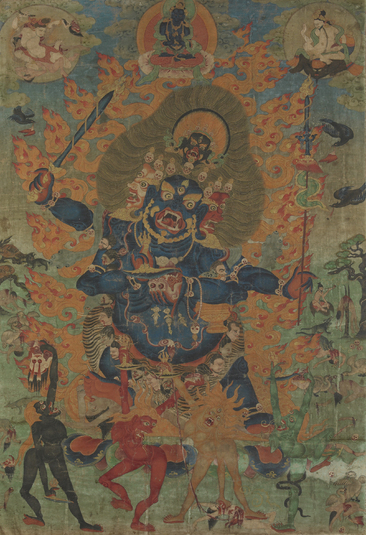
Item: Mahakala (Buddhist Protector) - Chaturmukha (Four-Faced)
| Origin Location | Tibet |
|---|---|
| Date Range | 1700 - 1799 |
| Lineages | Gelug and Buddhist |
| Material | Ground: Cotton |
| Collection | Yale University Art Gallery |
| Catalogue # | 1988.76.12 |
Classification: Deity
Appearance: Wrathful
Gender: Male
Mahakala, Chaturmukha (Four-faced Great Black One) associated with the Guhyasamaja Tantra along with the Twenty-five and Fifty Chapter Mahakala Tantras. This painting was done by a known artist, recognized by the many other works in museum and private collections, dated to between the late 1700s and the early 1800s.
This form of Mahakala with four faces and four arms is rarely depicted in art and virtually never shown to those who are uninitiated. The early Sakya Teachers devised a simplified form of the deity to be depicted on paintings as a place card-holder for the true image and form which was considered too secret and dangerous to display publicly. The simplified form is that of Brahmarupa Mahakala. (See below for a short history).
Mahakala has four faces, four arms and two legs. The main face is blue-black and the right white and the left red. The top face is black. The first pair of hands hold a curved knife and a skullcup. The second pair of hands holds a raised sword in the right and a spear in the left. The right leg is bent and the left straight standing atop a prone corpse-like figure. Standing in front, ghoulish in appearance, dynamic in posture, are the four attendant dakinis; Dombini, Chandali, Rakshasi and Singhali Devi - black, red, yellow and green in colour.
At the top center is the primordial buddha Vajradhara, blue in colour, holding a vajra and bell to the heart. At the right and left sides are Indian mahasiddha figures, one sitting on a corpse and the other on a deer skin.
The background landscape depicts a charnal ground scene with human remains, wild animals, impaled bodies, wolves and vultures. In the sky are three black birds with scavenged human organs of heart and eyeballs in their beaks.
A Short History of Chaturmukha & Brahmarupa Mahakala: When the great Tibetan Translator Nyen Lotsawa received the Manjuvajra Guhyasamaja (also known as the Jnanapada Lineage) empowerment from the dakini Risula, she also bestowed the initiation of the Mahakala (Chaturmukha) in the special form according to the Guhyasamaja Tantra. At this time she gave him as a servant a dark skinned Brahman. When Nyen Lotsawa and the Brahman reached Nepal the servant changed appearance and took on the form of a monk, an appearance more conducive for travelling in Tibet. After the passing of Nyen Lotsawa the monk remained with Lama Nam Ka'upa and then later with Sachen Kunga Nyingpo.
Brahmarupa Mahakala is none other than Chaturmukha Mahakala of the Guhyasamaja Tantra. In his wrathful appearance he is black in colour with four faces and four hands, surrounded by the four dakinis. In the Sakya School it is inappropriate to show the wrathful form to anyone who has not received the initiation. For this reason the iconographic tradition arose for painting Chaturmukha in the form of the Brahman servant of Nyen Lotsawa. At the bottom of many Sakya paintings it is a common theme to see Panjarnata Mahakala flanked by the Brahman on the right and Shri Devi (Palden Lhamo) on the left - the three main protectors of the Sakya School.
In later times the Gelug School of Tsongkapa adopted the Guhyasamaja practices and the Chaturmukha Mahakala. Many more paintings and depictions of the four faced deity were made and less emphasis was placed on secrecy. The vast majority of Tibetan and Mongolian paintings of Chaturmukha are Gelugpa.
Indian Lineage: Vajradhara, Nagarjuna, Balimtapa, Buddhajnana, Marmedze Zangpo, Shrideva, Drime Bepa, Ratnavajra, Ratnakirti, Risula Dakini, Nyen Lotsawa, Lama Nam Ka'upa, Sachen Kunga Nyingpo, etc.
Jeff Watt, 1-2010

Mahakala: Chaturmukha (Four-faced, Masterworks)
Mahakala: Chaturmukha (Four-faced) Main Page
Collection of Yale University Art Gallery
Artist: Khazi Lhazo Page
Mahakala: Chaturmukha - Accomplishment
Artist: Khazi Lhazo (Protector Deities)
